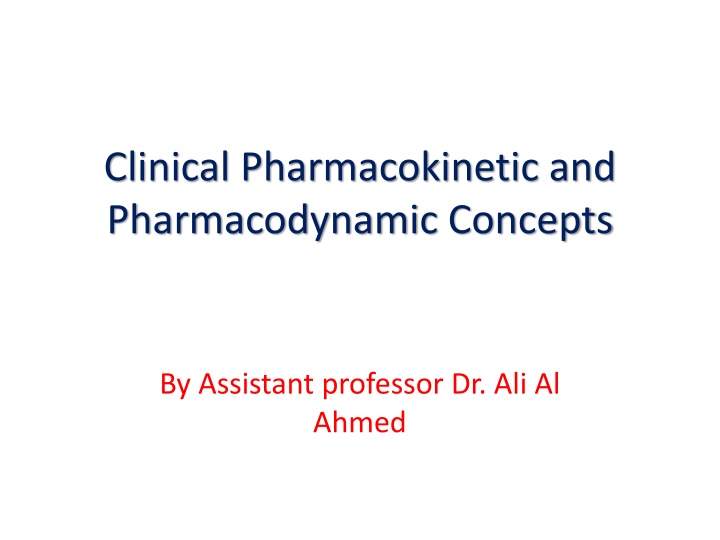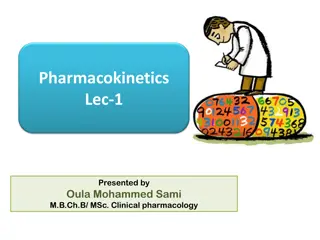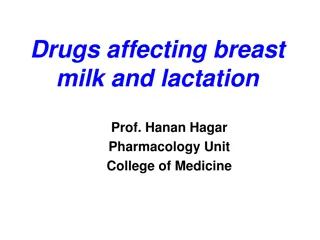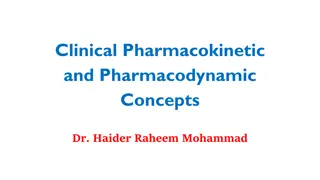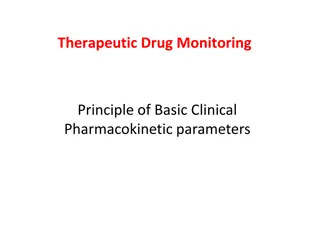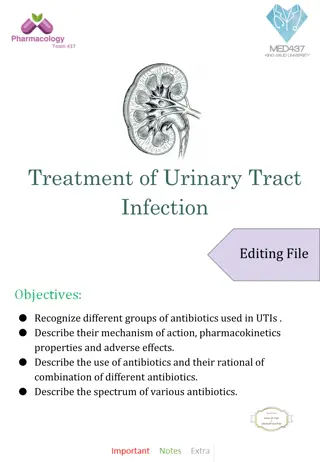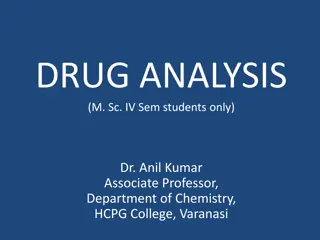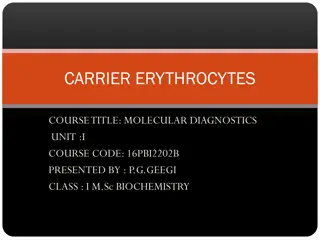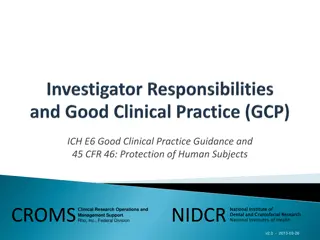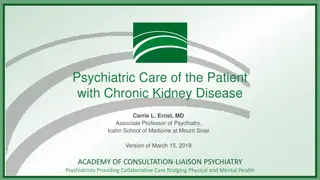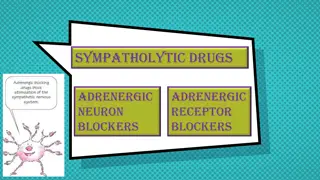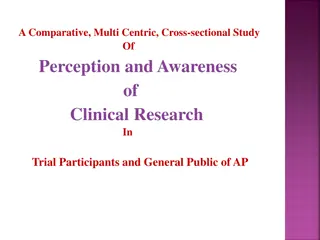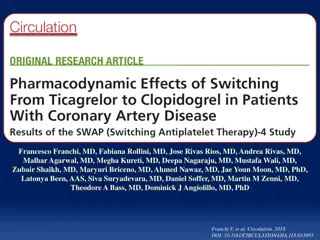Clinical Pharmacokinetic and Pharmacodynamic Concepts
Pharmacokinetics involves the absorption, distribution, metabolism, and excretion of drugs, while pharmacodynamics explores the relationship between drug concentration and response. Understanding these concepts is crucial for clinicians to optimize dosage regimens and assess patient responses accurately. The interplay between drug properties and physiological processes determines the effectiveness and safety of drug therapy.
Download Presentation

Please find below an Image/Link to download the presentation.
The content on the website is provided AS IS for your information and personal use only. It may not be sold, licensed, or shared on other websites without obtaining consent from the author.If you encounter any issues during the download, it is possible that the publisher has removed the file from their server.
You are allowed to download the files provided on this website for personal or commercial use, subject to the condition that they are used lawfully. All files are the property of their respective owners.
The content on the website is provided AS IS for your information and personal use only. It may not be sold, licensed, or shared on other websites without obtaining consent from the author.
E N D
Presentation Transcript
Clinical Pharmacokinetic and Pharmacodynamic Concepts By Assistant professor Dr. Ali Al Ahmed
Pharmacokinetics is the study of the absorption, distribution, metabolism, and excretion of drugs. When drugs are given extravascularly (e.g., orally, intramuscularly, applied transdermal patch, etc.), absorption must take place for the drug molecules to reach the systemic circulation. to the skin via a In order to be absorbed, the drug molecules must pass through several physiological barriers before reaching the vascular system.
Distribution occurs when drug molecules that have entered the vascular system pass from the bloodstream into various tissues and organs such as the muscle or heart. Metabolism is the chemical conversion of the drug molecule, usually by an enzymatically mediated reaction, into another chemical entity referred to as a metabolite. The pharmacological effect as the parent drug, or even cause toxic side effects. metabolite may have the same, or different, Excretion is the irreversible removal of drug from the body and commonly occurs via the kidney or biliary tract.
Pharmacodynamics is the relationship between drug concentration and pharmacological response. It is extremely important for clinicians to realize that the change in drug effect is usually not proportional to the change in drug dose or concentration. For example, when a drug dose or concentration is increased from a baseline value, the increase in pharmacological effect is greater when the initial dose or concentration is low compared to the change in drug effect observed when the initial dose or concentration is high.
LINEAR VERSUS NONLINEAR PHARMACOKINETICS: Regardless of the mode of drug administration, when the rate of drug administration equals the rate of drug removal, the amount of drug contained in the body reaches a constant value. LINEAR VERSUS NONLINEAR PHARMACOKINETICS: This equilibrium condition is known as steady state and is extremely important in clinical pharmacokinetics because usually steady-state serum or blood concentrations are used to assess patient response and compute new dosage regimens. If a patient is administered several different doses until steady state is established, and steady-state serum concentrations are obtained from the patient after each dosage level, it is possible to determine a pattern of drug accumulation.
If a plot of Steady state concentration versus dose yields a straight line, the drug is said to follow linear pharmacokinetics. When steady-state concentrations change in a disproportionate fashion after the dose is altered, a plot of steady-state concentration versus dose is not a straight line and the drug is said to follow nonlinear pharmacokinetics. When steady-state concentrations increase more than expected after a dosage increase, the most likely explanation is that the processes removing the drug from the body have phenomenon is known as saturable or Michaelis- Menten pharmacokinetics. become saturated. This
When doses are increased for most drugs, steady-state concentrations increase in a proportional fashion leading to linear pharmacokinetics (solid line). However, in some cases proportional increases in steady- state concentrations do not occur after a dosage increase. When steady-state concentrations increase more than expected after a dosage increase (upper dashed line), Michaelis-Menten pharmacokinetics may be taking place. If steady-state concentrations increase less than expected after a dosage increase (lower dashed line), saturable plasma protein binding or autoinduction are likely explanations.
Both phenytoin and salicylic acid follow Michaelis-Menten pharmacokinetics. Some drugs, such as valproic acid and disopyramide, saturate plasma protein binding sites so that as the dosage is increased steady-state serum concentrations increase less than expected. Other drugs, such as carbamazepine, increase their own rate of metabolism from the body as dose is increased so steady- state serum concentrations increase less than anticipated. This process is known as autoinduction of drug metabolism. Drugs oftentimes very difficult to dose correctly. that exhibit nonlinear pharmacokinetics are
New steady-state concentration = (new dose/old dose) concentration old steady-state
CLEARANCE: o Clearance (Cl) is the most important pharmacokinetic parameter because it determines the maintenance dose (MD) that is required to obtain a given steady- state serum concentration (Css): MD = Css Cl. o If one knows the clearance of a drug, and wants to achieve a certain steady-state serum concentration, it is easy to compute the required maintenance dose. o The definition of clearance is the volume of serum or blood completely cleared of the drug per unit time. Thus, the dimension of clearance is volume per unit time, such as L/h or mL/min.
The therapeutic range should be considered as an initial guideline for drug concentrations in a specific patient; drug dose and steady-state concentrations should then be titrated and individualized based on therapeutic response. For example, the therapeutic range for theophylline is generally accepted as 10 20 g/mL for the treatment of asthma with concentrations of 8 12 g/mL considered as a reasonable starting point. If it were known that the theophylline clearance for a patient equaled 3 L/h and the desired steady-state theophylline serum concentration was 10 g/mL, the theophylline maintenance concentration would be 30 mg/h (10 g/mL = 10 mg/L; MD = Css Cl; MD = 10 mg/L 3 L/h = 30 mg/h). dose to achieve this
The majority of drug metabolism is catalyzed by enzymes contained in the microsomes of hepatocytes known as the cytochrome P-450 (CYP) enzyme system. This family of enzymes is very important to understand because specific enzymes metabolism of each drug entity. are responsible for the Once it is known that a patient is deficient in one of the enzymes, usually because the clearance of a known drug substrate is very low resulting in high steady-state serum concentrations for a low to moderate dose, it can be inferred that all drugs metabolized by that enzyme will have a low clearance, and doses of other drugs that are substrates of the enzyme may be empirically reduced.
As an example of the classification scheme, the enzyme known as CYP3A4 is named because it is part of the cytochrome P-450 family, the major family group is 3, the subfamily group within the family is A, and the specific, individual enzyme within the subfamily is 4. Thus, using this scheme, one can tell that CYP2C9 and CYP2E1 belong to the same family, and CYP2C9 and CYP2C19 belong to the same subfamily and are closely related, but are different enzymes.
Some ethnic groups are deficient in certain enzyme families to a varying extent, and this information is included. P-glycoprotein (PGP) is a transport protein responsible for the active secretion of drugs into the bile, urine, and gastrointestinal tract. The kidney eliminates drugs by glomerular filtration and tubular secretion in the nephron. Once drug molecules have entered the urine by either of these processes, it is possible that the molecules may reenter the blood via a process known as tubular reabsorption. Glomerular filtration and, usually, tubular reabsorption are passive processes.
The clearance for an organ, such as the liver or kidney, that metabolizes or eliminates drugs is determined by the blood flow to the organ and the ability of the organ to metabolize or eliminate the drug. Liver blood flow (LBF) and renal blood flow (RBF) are each ~ 1 1.5 L/min in adults with normal cardiovascular function. The ability of an organ to remove or extract the drug from the blood or serum is usually measured by determining the extraction ratio (ER), which is the fraction of drug removed by the organ, and is computed by measuring the concentrations of the drug entering (Cin) and leaving (Cout) the organ: ER = (Cin Cout)/Cin.
o The extraction ratio is oftentimes determined during the drug development process, and knowledge of this parameter can be extremely useful pharmacokinetics of a drug will change during a drug interaction or if a patient develops hepatic, renal, or cardiac failure. in determining how the o The drug clearance for an organ is equal to the product of the blood flow to the organ and the extraction ratio of the drug. o Therefore, hepatic clearance (ClH) for a drug would be determined by taking the product of liver blood flow and the hepatic extraction ratio (ERH) for the drug (ClH = LBF ERH). o ERH), and renal clearance (ClR) for a medication would be determined by multiplying renal blood flow and the renal extraction ratio for the agent (ClR = RBF ERR). For example, verapamil has a hepatic extraction ratio of 90% (ERH = 0.90).
For patients with normal liver blood flow (LBF = 1.5 L/min), hepatic clearance would be expected to equal 1.35 L/min (ClH = LBF ERH, ClH = 1.5 L/min 0.90 = 1.35 L/min for verapramil. The total clearance for a drug is the sum of the individual clearances for each organ that extracts the medication. For example, the total clearance (Cl) for a drug that is metabolized by the liver and eliminated by the kidney is the sum of hepatic and renal clearance for the agent: Cl = ClH + ClR.
Hepatic Clearance: o It may be a function of the intrinsic ability of the enzyme to metabolize a drug (intrinsic clearance); the fraction of drug present in the bloodstream that is not bound to cells or proteins, such as albumin, 1-acid glycoprotein, or lipoproteins, but is present in the unbound, or free, state (unbound fraction of drug); and liver blood flow. o The intrinsic clearance (Cl int) is the inherent ability of the enzyme to metabolize the drug and is the quotient of the Michaelis-Menten constants Vmax (maximum rate of drug metabolism) and Km (drug concentration at which the metabolic rate equals Vmax/2; Cl int = Vmax/Km) for the unbound drug.
The unbound fraction of drug in the blood or serum (fB) is the unbound drug concentration divided by the total (bound + unbound) drug concentration. The relationship between the three physiological factors and hepatic drug clearance is: Fortunately, most drugs have a large hepatic extraction ratio (ERH 0.7) or a small hepatic extraction ratio (ERH 0.3), and the relationship is simplified in these situations.
For drugs with a low hepatic extraction ratio, hepatic clearance is mainly a product of the free fraction of the drug in the blood or serum and intrinsic clearance: ClH = fB Cl int. In this case, drug interactions that displace drug molecules bound to proteins will increase the fraction of unbound drug in the blood ( fB); more unbound drug molecules will be able to leave the vascular system (drug-protein complexes are far too big to exit the vascular system) and enter hepatocytes where the additional unbound drug will be metabolized and hepatic drug clearance will increase. For drugs with high hepatic extraction ratios, hepatic clearance is mainly a function of liver blood flow: ClH = LBF. The rate limiting step for drug metabolism in this case is how much drug can be delivered to the liver because the capacity to metabolize drug is very large. In this case, hepatic clearance is very sensitive to changes in liver blood flow due to congestive heart failure or liver disease.
Renal Clearance: The physiological determinants of renal clearance are glomerular filtration rate (GFR), the free fraction of drug in the blood or serum (fB), the clearance of drug via renal tubular secretion (Clsec), and the fraction of drug reabsorbed in the kidney (FR): ClR = [(fB GFR) + Clsec](1 FR). Average glomerular filtration rates in adults with normal renal function are 100 120 mL/min. Since tubular secretion is an active process, it has been described by an equation similar to that used to explain liver metabolism: Clsec = [RBF (fBCl sec)] / [RBF + (fBCl sec)], where Cl sec is the intrinsic clearance due to active tubular secretion. Thus, the entire equation is:
o If the renal clearance of a drug is greater than glomerular filtration rate, it is likely that the drug was eliminated, in part, by active tubular secretion. o The eliminated primarily by glomerular filtration. Digoxin, procainamide, ranitidine, and ciprofloxacin are eliminated by both glomerular filtration and active tubular secretion. aminoglycoside antibiotics and vancomycin are o In some cases, glomerular filtration rate and renal tubular secretion function may be measured in patients with renal disease. o However, for the purposes of drug dosing, glomerular filtration rate is approximated by measuring or estimating creatinine clearance for a patient.
VOLUME OF DISTRIBUTION: Volume of distribution (V) is an important pharmacokinetic parameter because it determines the loading dose (LD) that is required to achieve a particular steady-state drug concentration immediately after the dose is administered: LD = Css V Usually an average volume of distribution measured in other patients with similar demographics (age, weight, gender, etc.) and medical conditions (renal failure, liver failure, heart failure, etc.) is used to estimate a loading dose. The volume of distribution can be very small if the drug is primarily contained in the blood (warfarin V = 5 7 L), or very large if the drug distributes widely in the body and is mostly bound to bodily tissues (digoxin V = 500 L).
The physiologic determinates of volume of distribution are the actual volume of blood (VB) and size (measured as a volume) of the various tissues and organs of the body (VT). The drug binds in the blood or serum compared to the binding in tissues is also an important determinate of the volume of distribution for a drug. For example, the reason warfarin has such a small volume of distribution is that it is highly bound to serum albumin so that the free fraction of drug in the blood (fB) is very small. Digoxin has a very large volume of distribution because it is very highly bound to tissues (primarily muscle) so that the free fraction of drug in the tissues fT; fT = unbound drug concentration in the tissue/total tissue drug concentration) is very small.
HALF-LIFE AND ELIMINATION RATE CONSTANT: When drugs that follow linear pharmacokinetics are given to humans, serum concentrations decline in a curvilinear fashion:
When semilogarithmic decrease in a linear fashion after drug absorption and distribution phases are complete: the same data is plotted concentrations on a axis, serum
The time that it takes for serum concentrations to decrease by 1/2 in the elimination phase is a constant and is called the half- life (t1/2). The half-life describes how quickly drug serum concentrations decrease in a patient after a medication is administered, and the dimension of half-life is time (hour, minute, day, etc.). Another common measurement used to denote how quickly drug serum concentrations decline in a patient is the elimination rate constant (ke). If the amount of drug in the body is known, the elimination rate for the drug can be computed by taking the product of the elimination rate constant and the amount of drug in the body (AB): Elimination rate = AB ke. The half-life and elimination rate constant are related to each other by the following equation, so it is easy to compute one once the other is known: t1/2 = 0.693/ke.
The elimination rate constant can also be measured graphically by computing the slope of the log concentration versus time graph during the elimination phase: using log10, ke/2.303 = (log C1 log C2) / (t1 t2); or, using natural logarithms, ke = (ln C1 ln C2)/(t1 t2). The half-life is important because it determines the time to steady state during the continuous dosing of a drug and the dosage interval. The approach to steady-state serum concentrations is an exponential function. If a drug is administered on a continuous basis for 3 half-lives, serum concentrations are ~90% of steady-state values; on a continuous basis for 5 half-lives, serum concentrations equal ~95% of steady-state values; or on a continuous basis for 7 half-lives, serum concentrations achieve ~99% of steady-state values
Serum concentration/time graph for a drug that has a half-life equal to 8 hours.
The half-life and elimination rate constant are known as dependent parameters because their values depend on the clearance (Cl) and volume of distribution (V) of the agent: t1/2 = (0.693 V)/Cl, ke = Cl/V. The half-life and elimination rate constant for a drug can change either because of a change in clearance or a change in the volume of distribution. Because the values for clearance and volume of distribution depend solely parameters and can vary independently of each other, they are known as independent parameters. on physiological
MICHAELIS-MENTEN OR SATURABLE PHARMACOKINETICS Drugs that are metabolized by the cytochrome P-450 enzymes and other enzyme systems may undergo Michaelis- Menten or saturable pharmacokinetics. This is the type of nonlinear pharmacokinetics that occurs when the number of drug molecules overwhelms or saturates the enzyme s ability to metabolize the drug. When this occurs, steady-state drug serum concentrations increase in a disproportionate manner after a dosage increase. In this case the rate of drug removal is described by the classic Michaelis- Menten relationship that is used for all enzyme systems: Rate of metabolism = (Vmax C)/ (Km + C), where Vmax is the maximum rate of metabolism, C is the substrate concentration, and Km is the substrate concentration where the rate of metabolism = Vmax/2.
The clinical implication of Michaelis-Menten pharmacokinetics is that the clearance of a drug is not a constant as it is with linear pharmacokinetics, but is concentration- or dose-dependent. As the dose or concentration increases, the clearance rate (Cl) decreases as the enzyme approaches saturable conditions: Cl = Vmax/(Km + C). This is the reason concentrations increase disproportionately after a dosage increase. For example, phenytoin follows saturable pharmacokinetics with average Michaelis-Menten constants of Vmax = 500 mg/d and Km = 4 mg/L. The therapeutic range of phenytoin is 10 20 mg/L. As the steady-state concentration of phenytoin increases from 10 mg/L to 20 mg/L, clearance decreases from 36 L/d to 21 L/d [Cl = Vmax/(Km + C); Cl = (500 mg/d) / (4 mg/L + 10 mg/L) = 36 L/d; Cl = (500 mg/d)/(4 mg/L + 20 mg/L) = 21 L/d].
Unfortunately, there is so much inter patient variability in Michaelis-Menten pharmacokinetic parameters for a drug (typically Vmax = 100 1000 mg/d and Km = 1 10 mg/L for phenytoin) that dosing drugs which follow saturable metabolism is extremely difficult. The volume of distribution (V) is unaffected by saturable metabolism and is still determined by the physiological volume of blood (VB) and tissues (VT) as well as the unbound concentration of drug in the blood (fB) and tissues (fT): V = VB + (fB/fT)VT.
Since clearance is dose- or concentration- dependent, half-life also changes with dosage or concentration changes. As doses or concentrations increase for a drug that follows Michaelis-Menten pharmacokinetics, clearance decreases and half-life becomes longer for the drug: t1/2 = (0.693 V)/ Cl. The clinical implication of this finding is that the time to steady state (3 5 t1/2) is longer as the dose or concentration is increased for a drug that follows saturable pharmacokinetics.
o Under steady-state conditions the rate of drug administration equals the rate of drug removal. o Therefore, for a drug that is solely removed by metabolism via one enzyme system, the Michaelis-Menten equation can be used to compute the maintenance dose (MD) required to achieve a target steady-state serum concentration (Css):
When the therapeutic range for a drug is far below the Km value for the enzymes that metabolize the drug Css, this equation simplifies to: MD = (Vmax/Km)Css or, since Vmax/Km is a constant, MD = Cl Css. Therefore, when Km >> Css, drugs that are metabolized follow linear pharmacokinetics. When the therapeutic range for a drug is far above the Km value for the enzyme system that metabolizes the drug, the rate of metabolism becomes a constant equal to Vmax. Under these conditions only a fixed amount of drug is metabolized because the enzyme system is completely saturated and cannot increase its metabolic capacity. This pharmacokinetics. First order pharmacokinetics is another name for linear pharmacokinetics. situation is also known as zero-order
BIOAVAILABILITY: It is the fraction of the administered extravascular dose that is delivered to the systemic circulation and it is specific for the drug and dosage form. During absorption from extravascular routes, drug serum concentrations rise while the drug is being absorbed into the bloodstream, reach a maximum concentration (Cmax) when the rate of drug absorption equals the rate of drug elimination, and eventually decrease according to the half- life of the drug. The phase of the curve over which absorption takes place is known as the absorption phase, and the time that the maximum concentration occurs is called Tmax.
Area under the serum concentration/time curve (AUC), the maximum concentration (Cmax), and the time that the maximum concentration occurs (Tmax) are considered primary bioavailability parameters. When the AUC, Cmax, and Tmax are the same within statistical limits for two dosage forms of the same drug, the dosage forms are considered to be bioequivalent.
o Drugs that are substrates for CYP3A4 and CYP2D6 are particularly susceptible to presystemic metabolism by the liver. o Blood leaving the liver via the hepatic vein enters the inferior vena cava, and will eventually be pumped through the lung by the right side of the heart before entering the left side of the heart and being pumped into the arterial system. To a lesser extent, some drugs are metabolized by the lung or irreversibly eliminated into expired air. o For drugs that follow linear pharmacokinetics, bioavailability is measured by comparing serum concentrations achieved after extravascular and intravenous doses in the same individual. o Rather than compare drug concentrations at each time point, a composite of drug concentrations over time is derived by measuring the total area under the serum concentration time curve (AUC) for each route of administration
F = = AUCPO/AUCIV. If it is not possible to administer the same dose intravenously and extravascularly absorption or presystemic metabolism yields serum concentrations that are too low to measure, the bioavailability calculation can be corrected to allow for different size doses for the different routes of administration: F = (AUCPO/AUCIV)(DIV/DPO), where DIV is the intravenous dose and DPO is the oral dose. because poor
Bioequivalence: In theory, it should be possible to substitute a bioequivalent generic drug dosage form for a brand name product without a change in steady-state drug serum concentrations or therapeutic efficacy. In order to achieve the Food and Drug Administration s (FDA) definition of oral bioequivalance and be awarded an AB rating in the FDA publication Approved Drug Products with Therapeutic Equivalence Evaluations (also known as The Orange Book), the pharmaceutical company producing a generic drug product must administer single doses or multiple doses of the drug until steady state is achieved using both the generic and brand name drug dosage forms to a group of 18 24 humans and prove that the AUC (from time = 0 to infinity after a single dose, or over the dosage interval at steady state), Cmax, and Tmax values are statistically identical for the two dosage forms.
o The ratio of the area under the serum concentration/time curves (AUCgeneric) and brand name (AUCbrand) drug dosage forms is known bioavailability (Frelative) since the reference AUC is derived from the brand name drug dosage form: Frelative = AUCgeneric/AUCbrand. for the generic as the relative o Many states allow the substitution of generic drugs for brand name drugs if the prescriber notes on the prescription order that generic substitution is acceptable, and the generic drug dosage form has an AB rating.
